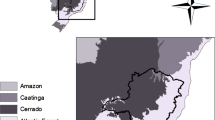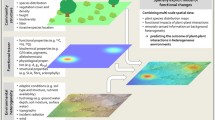Abstract
The environmental texture hypothesis (ETH) proposes that the spatial geometry or texture of the environment influences the rate at which species are accumulated in space or time. Specifically, the ETH suggests that regions, and spatial scales, that exhibit a larger rate of environmental distance decay (DD) should exhibit more rapid rates of species turnover. The ETH should apply over any range of scales where the environment is driving species distributions. To examine the relevance of the ETH at local spatial scales, we tested for a positive relationship between the rate of change in soil chemical properties and vascular plant species composition in grassland and woodland habitats. We recorded presence–absence data along a 1.883 km transect in each habitat and estimated the rate of turnover and environmental DD for spatial lags of 1–41 m. We found that the soil environment explained spatial patterns of species composition more accurately in the grassland habitat compared to the woodland habitat. Consequently the rate of change in soil properties as a function of spatial distance was significantly positively correlated with the rate of species turnover in the grassland but not the woodland. Our study suggests that one of the central premises of the ETH is relevant for local patterns of species turnover if the environment appears to influence species composition.





Similar content being viewed by others

References
Adler PB, Raff DA, Lauenroth WK (2001) The effect of grazing on the spatial heterogeneity of vegetation. Oecologia 128:465–479. doi:10.1007/s004420100737
Allen MS, Hamilton RG, Melcher U, Palmer MW (2009) Lessons from the prairie: research at The Nature Conservancy’s tallgrass prairie preserve. Oklahoma Academy of Sciences, Stillwater
Bacaro G, Ricotta C (2007) A spatially explicit measure of beta diversity. Commun Ecol 8:41–46
Bell G, Lechowicz MJ et al (1993) The spatial structure of the physical environment. Oecologia 96:114–121
Brokaw JM (2004) Comparing explanatory variables in the analysis of species composition of a tallgrass prairie. Proc Okla Acad Sci 84:33–40
Buckley LB, Jetz W (2008) Linking global turnover of species and environments. Proc Natl Acad Sci 105:17836–17841. doi:10.1073/pnas.0803524105
Cody ML (1975) Towards a theory of continental species diversities: bird distribution over Mediterranean habitat gradients. In: Cody ML, Diamond JM (eds) Ecology and evolution of communities. Belknap Press of Harvard University, Cambridge, pp 214–257
Fuhlendorf SD, Engle DM (2004) Application of the fire-grazing interaction to restore a shifting mosaic on tallgrass prairie. J Appl Ecol 41:604–614
Galhidy L, Mihok B, Hagyo A, Rajkai K, Standovar T (2006) Effects of gap size and associated changes in light and soil moisture on the understorey vegetation of a Hungarian beech forest. Plant Ecol 183:133–145. doi:10.1007/s11258-005-9012-4
Gauch HG Jr (1982) Multivariate analysis in community ecology. Cambridge University Press, New York
Gauch HG Jr, Whittaker RH (1972) Coenocline simulation. Ecology 53:446–451
Graves JH, Peet RK, White PS (2006) The influence of carbon-nutrient balance on herb and woody plant abundance in temperate forest understories. J Veg Sci 17:217–226
Hubbell SP (2001) The unified neutral theory of biodiversity and biogeography. Princeton University Press, Princeton
Hutchinson TF, Boerner REJ et al (2005) Prescribed fire effects on the herbaceous layer of mixed-oak forests. Can J For Res 35:877–890
Journel AG, Huijbregts C (1978) Mining geostatistics. Academic Press, London
Koleff P, Gaston KJ, Lennon JJ (2003) Measuring beta diversity for presence–absence data. J Anim Ecol 72:367–382
Legendre P (1993) Spatial autocorrelation: trouble or new paradigm? Ecology 74:1659–1673
Legendre P, Gallagher ED (2001) Ecologically meaningful transformations for ordination of species data. Oecologia 129:271–280
Legendre P, Legendre L (1998) Numerical ecology. Elsevier, Boston
Legendre P, Borcard D, Peres-Neto PR (2005) Analyzing beta diversity: partitioning the spatial variation of community composition data. Ecol Monogr 75:435–450
Ludwig F, de Kroon H, Berendse F, Prins HHT (2004) The influence of savanna trees on nutrient, water and light availability and the understorey vegetation. Plant Ecol 170:93–105
McGill BJ (2010) Towards a unification of unified theories of biodiversity. Ecol Lett 13:627–642
McGlinn DJ, Palmer MW (2009) Modeling the sampling effect in the species–time–area relationship. Ecology 90:836–846. doi:10.1890/08-0377.1
McGlinn DJ, Palmer MW (2010) Spatial structure alters the shape of the unimodal species richness-biomass relationship in a neutral model. Diversity 2:550–560
Nekola JC, White PS (1999) The distance decay of similarity in biogeography and ecology. J Biogeogr 26:867–878
Noy-Meir I, Anderson D (1971) Multiple pattern analysis or multiscale ordination: towards a vegetation hologram. In: Patil GP, Pielou EC, Water EW (eds) Statistical ecology: populations, ecosystems, and systems analysis. Pennsylvania State University Press, University Park, pp 207–232
Palmer MW (1988) Fractal geometry: a tool for describing spatial patterns of plant communities. Vegetatio 74:91–102
Palmer MW (1993) Potential biases in site and species selection for ecological monitoring. Environ Monit Assess 26:277–282
Palmer MW (2007) Species-area curves and the geometry of nature. In: Storch D, Marquet PL, Brown JH (eds) Scaling biodiversity. Cambridge University Press, Cambridge, pp 15–31
Palmer MW, van der Maarel E (1995) Variance in species richness, species association, and niche limitation. Oikos 73:203–213
Palmer MW, Arévalo JR, Cobo MC, Earls PG (2003) Species richness and soil reaction in a northeastern Oklahoma landscape. Folia Geobot 38:381–389
Palmer MW, McGlinn DJ, Fridley JF (2008a) Artifacts and artifictions in biodiversity research. Folia Geobot 43:245–257
Palmer MW, McGlinn DJ, Westerberg L, Milberg P (2008b) Indices for detecting differences in species composition: some simplifications of RDA and CCA. Ecology 89:1769–1771
Peres-Neto PR, Legendre P, Dray S, Borcard D (2006) Variation partitioning of species data matrices: estimation and comparison of fractions. Ecology 87:2614–2625
Qian H, Fridley JD, Palmer MW (2007) The latitudinal gradient of species–area relationships for vascular plants of North America. Am Nat 170:690–701
Reilly MJ, Wimberly MC, Newell CL (2006) Wildfire effects on beta-diversity and species turnover in a forested landscape. J Veg Sci 17:447–454
Rosenzweig ML (1995) Species diversity in space and time. Cambridge University Press, Cambridge
Schlup BM, Wagner HH (2008) Effects of study design and analysis on the spatial community structure detected by multiscale ordination. J Veg Sci 19:621–632
Storch D, Šizling AL, Gaston KJ (2003) Geometry of the species–area relationship in central European birds: testing the mechanism. J Anim Ecol 72:509–519
ter Braak CJF (1986) Canonical correspondence analysis: a new eigenvector technique for multivariate direct gradient analysis. Ecology 67:1167–1179
ter Braak CJF, Prentice IC (2004) A theory of gradient analysis. Adv Ecol Res 34:235–282
ter Braak CJF, Šmilauer P (2002) Canoco for windows version 4.5. Biometris—Plant Research International, Wageningen
Triantis KA, Mylonas M, Lika K, Vardinoyannis K (2003) A model for the species–area–habitat relationship. J Biogeogr 30:19–27
Vellend M (2001) Do commonly used indices of beta-diversity measure species turnover? J Veg Sci 12:545–552
Wagner HH (2003) Spatial covariance in plant communities: integrating ordination, geostatistics, and variance testing. Ecology 84:1045–1057
Wagner HH (2004) Direct multi-scale ordination with canonical correspondence analysis. Ecology 85:342–351
White EP, Gilchrist MA (2007) Effects of population-level aggregation, autocorrelation, and interspecific association on the species–time relationship in two desert communities. Evol Ecol Res 9:1329–1347
Whittaker RH (1960) Vegetation of the Siskiyou Mountains, Oregon and California. Ecol Monogr 30:279–338
Wilson MV, Shmida A (1984) Measuring beta diversity with presence absence data. J Ecol 72:1055–1064
Acknowledgments
DJM received postdoctoral funding from A. Hurlbert and doctoral funding from the U.S. Environmental Protection Agency (EPA) under the Greater Research Opportunities (GRO) Graduate Program. The U.S. EPA has not officially endorsed this publication, and the views expressed herein may not reflect the views of the Agency. MWP acknowledges support from National Science Foundation grants numbered EPS-0447262 and EPS-0919466. In addition, we thank The Nature Conservancy for logistical support and W. Lowry, O. Blinkova, V. Thapa, M. Allen, P. Earls, and C. Huang for assistance in the field.
Author information
Authors and Affiliations
Corresponding author
Rights and permissions
About this article
Cite this article
McGlinn, D.J., Palmer, M.W. Quantifying the influence of environmental texture on the rate of species turnover: evidence from two habitats. Plant Ecol 212, 495–506 (2011). https://doi.org/10.1007/s11258-010-9840-8
Received:
Accepted:
Published:
Issue Date:
DOI: https://doi.org/10.1007/s11258-010-9840-8



